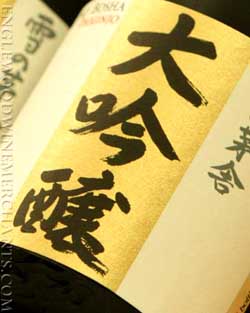Saké GlossaryPage 2: Sakés, Terms & Definitions I ~ NThis is Page 2 of the four-page Saké Glossary covering the different types of sakés. Click on the black links below to visit other pages. WHAT ARE YOUR FAVORITE FOODS?LEARN MORE ABOUT THEM IN OUR OTHER FOOD GLOSSARIES. Click on a letter to go to the appropriate glossary page: This glossary is protected by copyright and cannot be reproduced in whole or in part without written permission.
Infused Saké: Currently a product unique to the United States, where it is used for innovative cocktails, or drunk neat like infused vodka. Flavors such as yuzu, honey, ginger, lemongrass, pomegranate and asian pear, are added to the saké during the blending process. As with vodka, some restaurants and cocktail lounges infuse their own sakés. Commercial infused sakés tend to be lower in alcohol content than classic sakés. Jiu: Pronounced joe, the Chinese word used to describe the entire category of alcoholic beverages made from rice. Saké is one beverage in this category. Jizake: A term that usually refers to saké from smaller rural breweries, the antithesis of mass-produced saké. |
||
Junmai Saké or Junmaishu: Junmai is a pure rice distillate, with no added alcohol. Until recently, it was a saké with at least 30% of the grain removed; however, the laws have changed, and junmai no longer requires a specified milling rate (the amount milled away must, however, be listed on the label). Junmai often has a fuller, richer body and a higher-than-average acidity, but a less prominent nose than other types of saké. Junmais and ginjos can be paired with bigger flavors, like toro, grilled chicken and tempura. Along with honjozo, junmai is one of two broad categories of saké generally available in the U.S. It differs from honjozo in that no distilled alcohol is added (i.e., only rice, water, koji and yeast are used to make the saké). By law, sakés that are made in the U.S. cannot add distilled alcohol; so all domestic-made sakés are junmai style. FLAVOR PROFILE: Subtle nose, assertive, higher-acid, full-flavored, earthy notes, good finish. See also honjozo. |
 Yuki No Bosha, Cabin In The Snow Daijingo, available at EnglewoodWineMerchants.com. |
|
Kobo: The yeast used to make a seed mash called moto, in a room called the moto-ba. Kobo propagates itself by feeding on the koji rice. The propagation of koji and kobo are the most critical processes in brewing saké. Specialists called koji-ya and moto-ya supervise these processes. Koji: The unique enzyme required to make saké. Koji converts starch to glucose and are responsible for saké’s aroma and taste. Koji mold is cultivated on a bed of steamed rice, and the mold eats its way into the rice. The enzymes in the mold break down the rice’s starch molecules into smaller sugar molecules that are food for the moto required to brew the saké. Kojimuro: The room in which the koji conversion takes place (for up to two weeks). The temperature of the kojimuro is always kept at 86° Fahrenheit (30° Celsius). The moisture of the room is also controlled carefully in order to stimulate the multiplication of the koji. This is one of the most critical processes in saké-making. Kura: A sakéry, or place where saké is produced. Saké is very sensitive to temperature and can be brewed only during the winter. In order to sell saké throughout the year, brewers store saké in the kura, where the temperature change is relatively constant. In the old days, saké was stored in wooden tanks; but today, it is stored in enameled porcelain or stainless steel tanks. | ||
|
Continue To Page 3: Terms M Through R |
||
© Copyright 2005-2026 Lifestyle Direct, Inc. All rights reserved. All images are copyrighted to their respective owners.